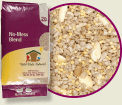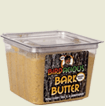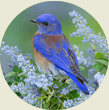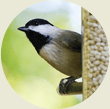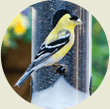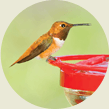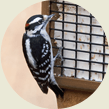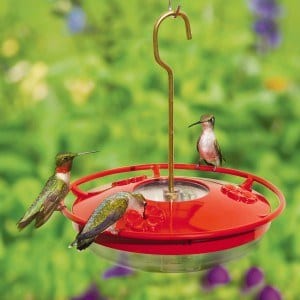 Hummingbirds have returned to most regions in North America, check out the Journey North map. We wanted to share these helpful tips to frequently asked questions regarding hummingbirds. A special thank you to Rosann Kovalcik, owner of the Wild Birds Unlimited store in Grosse Pointe Woods, MI, for sharing her hummingbird expertise with everyone.
Hummingbirds have returned to most regions in North America, check out the Journey North map. We wanted to share these helpful tips to frequently asked questions regarding hummingbirds. A special thank you to Rosann Kovalcik, owner of the Wild Birds Unlimited store in Grosse Pointe Woods, MI, for sharing her hummingbird expertise with everyone.
How do I make Hummingbird Nectar?
Commercial nectar that you purchase should be free of red dye. The sugar used in boxed nectar is superfine and can easily be made with boiled water, stirring until the sugar is dissolved. For a home-made version, the ratio is four parts water to one part sugar (ex: one cup of water to ¼ cup sugar). Boil the water to rid it of chlorination and allow the sugar to dissolve easily. Pour it over the sugar and stir until dissolved. Once cooled off, fill your feeder and keep the rest in a nectar bottle in the refrigerator. Do not use dyes, brown sugar or honey.
How often should Hummingbird Feeder Nectar be changed?
If the weather is cooler, 60 degrees, then leaving the nectar for two or three days is acceptable. However, on a 90? + day, the possibility of spoilage would require that you change the nectar after one day. Rinse your feeder out with hot water and clean the feeding ports with a brush to make sure that you prevent a build-up of mold.
Are there times of the year when I should make the nectar stronger?
On average, the nectar that flowers produce is the same strength of sweetness throughout their blooming period. Since what we put in our feeders mimics nature, keeping our nectar recipe the same is recommended.
What if hummingbirds are not coming to the bird feeder?
Since hummingbirds must wake up and refuel immediately, check at daybreak if you want to see if the feeder is being visited. Make sure that you are changing your nectar frequently – spoiled nectar means that they will visit and learn that your feeder is not a place to visit.
What do I do to keep flying insects out of the hummingbird feeder?
• Clean the Humming bird feeder inside and out. Don’t let sugar solution splash on the outside of the feeder as it is a further attractant to bees.
• Fill the nectar level lower than usual so the bees can’t reach it through the ports in a tray-style feeder. Sometimes this is about half-way full.
• Move the feeder even if it is a couple feet from the original location. When a bee scout finds the food it tells the others exactly where to find the source. If the source is not in the exact location then they don’t look around for it. The feeder will be bee-free till another scout comes across it. The birds will not have an issue with it being moved.
• A small bowl of higher concentration sugar water, like a 1:1, on the ground may ‘pull’ the bees to that source instead of the nectar feeder source.
• Pure almond extract around the ports has anecdotally worked for folks in the past. It doesn’t seem to bother or harm the birds.
• Check to see if there are any yellow parts on the feeder. Many popular hummingbird feeders have yellow feeder ports or decorations. Bees and wasps are attracted to the color yellow. Use bright red fingernail polish and paint over any yellow parts of the feeder. Apply several coats of nail polish, letting each dry before applying the next coat.
• Place the feeder away from anything that is yellow in your yard. This includes yellow flowers, lawn ornaments or decorations. Again, the yellow color will attract the unwanted insects.
You can find our complete selection of Hummingbird Feeders Here.

